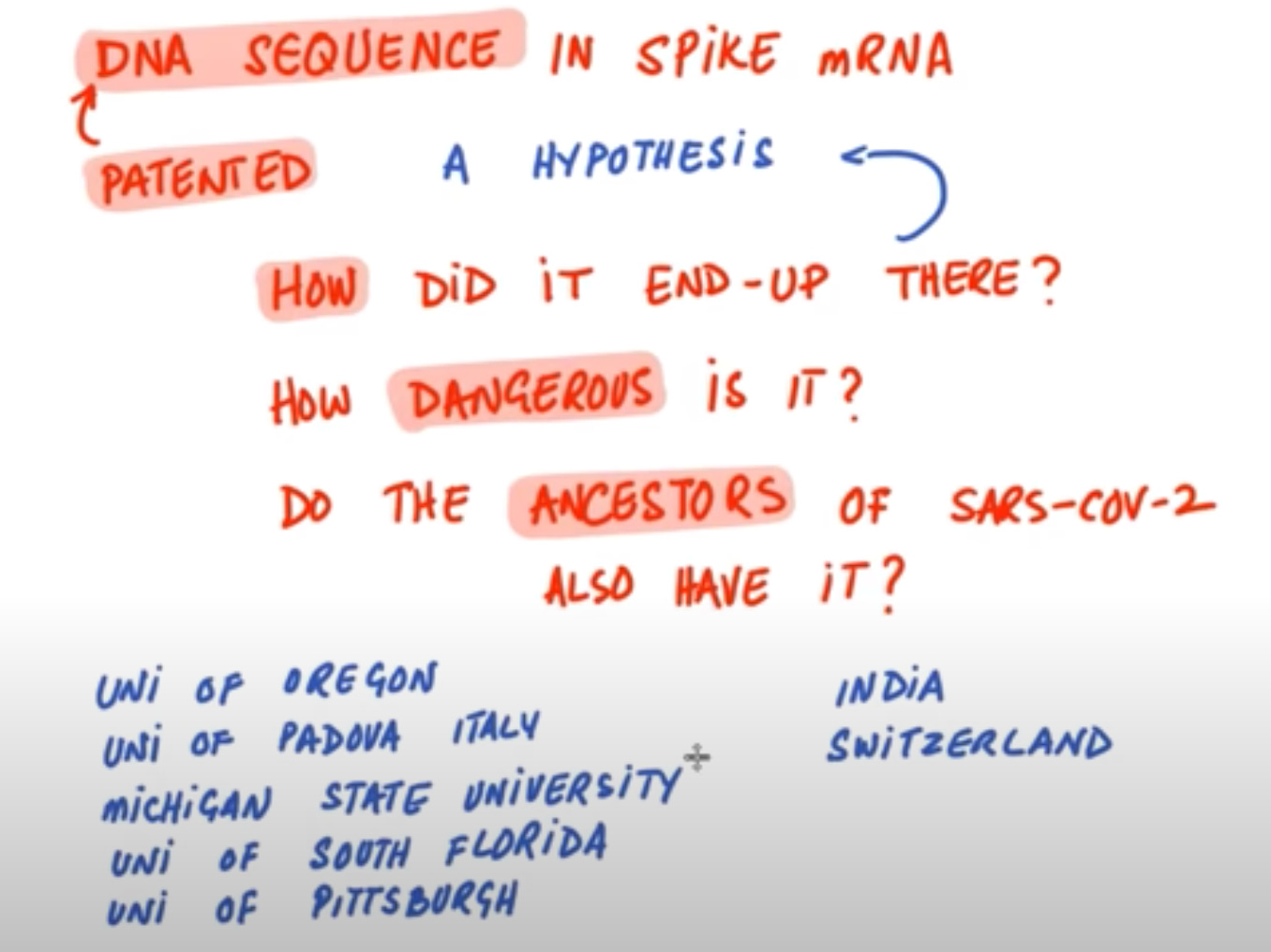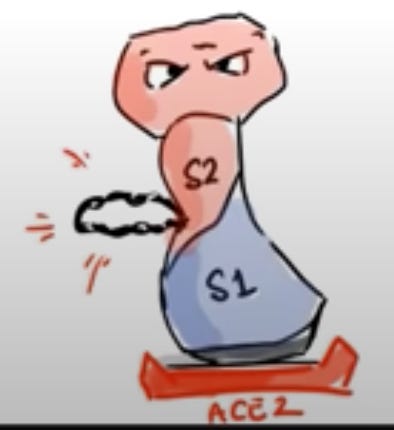Hypothesis that Spike Genes have Patented DNA Sequences Could Have Dangerous Implications
“People ask me: Why don’t you comment about where COVID came from? And I say: I haven’t seen it with my own eyes..how can I say where it came from?” Well now the door is part way open. Read on...
In February of this year, a pivotal study co-authored by nine researchers—many associated with leading US universities—appeared in Frontiers in Virology, raising important questions about the origins of a DNA sequence in the spike protein of the SARS-CoV-2 virus. The researchers compared the genetic sequences of SARS-CoV-2 and its closest known ancestor, RaTG13, and found that in the spike protein genes of the SARS-CoV-2 virus there is a sequence of 19 nucleotides that is wholly different from that found in RaTG13. When the researchers looked this sequence up in the genetic databases they found that it was a 100% match to a structure that was patented by Moderna Therapeutics, Inc. in March of 2017. 1
To understand this, and its potential implications, let’s back up a bit to provide some context and discuss some basics.
What is RaTG13?
In early February 2020, before the World Health Organization (WHO) declared a novel strain of a coronavirus was sweeping the globe, researchers including virologist Shi Zhengli, who directs the Centre for Emerging Infectious Diseases at the Wuhan Institute of Virology in China, reported in Nature that the genetic material making up SARS-CoV-2, was 96.2% identical to RaTG13, an unpublished bat coronavirus sequence. Shi, who researches SARS-like coronaviruses of bat origin, described RaTG13 as the “closest relative” to the novel virus, and said the two viruses were believed to form “a distinct lineage from other SARSr-CoVs.” 2
In a November 2020 addendum to the original Nature study, the researchers further confirmed this shared ancestry, but added that the original 13 serum samples from which RaTG13 had come, were collected by hospital staff between July and October of 2012 from 4 patients (one of them deceased) who had severe respiratory disease. The samples were sent to the Wuhan Institute of Virology. It’s believed that the patients encountered the virus when they were cleaning bat feces from a copper mine in Tongguan, a Chinese town in Yunnan Province. RaTG13 was named after the horseshoe bat species (Rhinolophus affinis), the location (Tongguan), and the sampling year (2013).3
According to a 2021 book by Canadian investigative journalist Elaine Dewar, the miners’ symptoms were very similar to those of SARS-CoV-2. In On the Origin of the Deadliest Pandemic in 100 Years, Dewar—drawing on a master’s thesis written by Dr. Xu Li, the doctor who treated the miners—wrote that the symptoms included, “dry cough, high fever, headache, sore limbs, severe pneumonia which showed up on x-rays as ground glass-like opacities, difficulty breathing, blood clots, etc.” The severity of the illness was also age-related. According to Dr. Xu Li’s thesis, some of the samples tested positive for a coronavirus, although it was not clear how many. 4
The “peculiar” dissimilarity between RaTG13 and SARS-CoV-2
All genetic material is made up of four building blocks called nucleotides: adenine, thymine, guanine, and cytosine. When three of these combine, they form what’s called a nucleotide triplet, or a codon. Each codon encodes for an amino acid, which are the building blocks of protein.
While RaTG13 and SARS-CoV-2 are 96.2% similar, they are also 3.8% different. The authors of the 2022 Frontiers in Virology study observed numerous point mutation differences between the two viruses, but they also observed an unusual cluster of mutations not present in RaTG13: a 12-nucleotide furin cleavage site (FCS) sequence, one that matched a sequence patented by Moderna in 2017.
The initial discovery of the FCS on the SARS-CoV-2 spike protein was made in April 2020 and reported in Antiviral Research by a group of researchers from France and Canada. The furin site on the spike is only found in one other betacoronavirus—MERS. They also found that the feature may “provide a gain-of-function” to the virus “for efficient spreading in the human population.”
The FCS has been the subject of numerous studies over the last two years, including here, here, here, and here. Essentially, what these studies confirm is that the FCS boosts viral entry and can wreak havoc with the human immune system, causing cytokine storms and potentially death. Alternately, the absence of the FCS results in “attenuated” or milder disease.
SARS-CoV-2 has this genetic material that forms this FCS “loop” on the spike protein. Until the recent study by Ambati et al, the FCS on SARS-CoV-2 had not been matched to the Moderna patented protein
In the recent 2022 study, when the researchers searched BLAST, it revealed that a 19-nucleotide portion of the SARS-CoV-2 genome encompassing the 12-nucleotide FCS is a “100% complementary match to a codon-optimized proprietary sequence,” owned by Moderna. While point mutations in viruses are not at all unusual, this many mutations in one location actually is unusual. The researchers described it as being “very rare” and a “peculiar feature.”
The study authors found that the insertion of 12-19 nucleotides also encodes for a protein that occurs naturally in the human body called MSH3, which was discovered in 1989 by Japanese scientists. At the time, its precise role had not been determined but a 1996 study shed more light on it when researchers found that it acts as a repair gene, and can recognize the errors in the DNA “much as a computer's spell check finds errors.” Researchers found that when MSH3 or other DNA repair genes have themselves been impaired, the errors remain uncorrected. “Over time, the accumulation of these errors can lead to cancer.” In other words, defective MSH3 can result in cancers, and gene therapy that corrects this defect could treat cancers.
Which brings us back to the recent study in Frontiers in Virology. The authors observed the presence of a “a codon-optimized mRNA sequence for human expression,” which they say, “likely has applications in cancers with mismatch repair deficiencies.”
All of us have MSH3 in our cells. But if a company wants to use it, say for gene therapy research for cancer treatment, it will try to stabilize it. This can be done by slightly altering the original nucleotide to create what’s called an “optimized nucleotide.” According to the study authors, the codons that appear in the SARS-CoV-2 virus are “human optimized,” therefore they represent a modified version of what would occur naturally.
Why is this insertion potentially dangerous?
So, while Moderna’s patenting of the MSH3 sequence for drug research purposes is a legitimate thing to do, two questions arise.
The first question is, what are the potential consequences of the presence of a “human optimized” mRNA sequence in the SARS-CoV-2 virus?
When the SARS-CoV-2 virus enters a cell, it replicates, creating more viruses, which means more FCS sequences, and more MSH3, added to what’s already there naturally. This over-expression of MSH3 disrupts the balance that’s required for these repair systems to work properly. Too much MSH3 can disrupt DNA repair, leading to more severe disease, longer recovery times, and possibly cause cancers.
The second question is, how did this spontaneous cluster of mutations appear in the SARS-CoV-2 virus when it was absent from its closest relative, RaTG13?
The authors of the 2022 study note there are a number of potential explanations for the correlation, including evolution, mutation, the accidental acquisition of the sequence from a human host, the accidental acquisition from lab cells, or a deliberate addition in a lab. They conclude that the matter should be “further investigated.”
https://video.twimg.com/ext_tw_video/1497107349063958530/pu/vid/1280x720/LSMp7IJztWlO2qC5.mp4?tag=12
In this recent Fox News clip, Moderna CEO, Stephane Bancel, was asked for his reaction to the study’s finding that a gene sequence present in SARS-CoV-2 matches a patent filed by Moderna three years before the pandemic. Here is Bancel’s reply:
My scientists are looking into those data to see how accurate they are or not. As I’ve said before, the hypothesis of an escape from a lab by an accident is possible. You know, human (sic) make mistakes. So is it possible that the Wuhan lab in China was working on virus enhancement or gene modification and then there was an accident where somebody was infected in the lab, and then infected their families and friends – it is possible. On the claim you just mentioned, the scientists are analyzing to know if it is real or not.
We’ll be keeping an eye on how this develops and will report on it here on Substack.
For more on this subject, please go to my medical lecture, “Spike Genes Have Patented DNA Sequences. This is Dangerous.”
Moderna’s patent (# US 9587003) was filed in February 2016 .
In her book, The Origin of the Deadliest Pandemic in 100 Years, Elaine Dewar points out that on the same day Shi Zhengli’s article was submitted to Nature, another article co-authored by her was submitted to Emerging Microbes and Infections, which was published just a few days before (January 31, 2020) the one in Nature (February 3, 2020). Unlike the Nature article, the article that appeared in EMI made no mention of RaTG13 being the closest (96.2%) sequence to SARS-CoV-2. Instead, she asserted that the closest sequences were two described by a Chinese military group, that were 82% and 89% identical to the novel virus, and were found in horseshoe bats (Rhinolopus sinicus) in Zhoushan city between 2015 and 2017. (Dewar, 2021, pp. 225-226)
As stated, RaTG13 shares 96.2% nucleotide similarity with SARS-CoV-2. The difference between the two, as noted here, is in the receptor-binding domain of the spike protein, which is the portion that binds to the receptor protein on the surface of the host cell and causes infection, suggesting RaTG13 may not bind efficiently to human ACE2. Also, the spike protein of RaTG13 does not have the furin cleavage motif.
Dr. Xu Li’s master’s thesis was titled “The analysis of 6 patients with severe pneumonia caused by unknown viruses.” According to the thesis, of the six patients with the illness, three of them died. In Dewar, 2021, p. 274, 280. For further reading on the subject of RaTG13, please go here.







Thanks, Dr. Mobeen. 🙂
The virus' possession of the patented furin cleavage site in the spike protein bothers me a lot. It has terrible effects upon our immune system.
But what bothers me much more is deliberately using the spike protein as a self-replicating, unmetered vaccine. Repeatedly vaccinating people (boosters). It is a colossal error in judgment I have been unable to wrap my head around. 🤯 It makes more sense to me as malevolent intent. 🤢
I'm surprised Dr. Been did not mention lab origin angle here. See the Nerd Has Power article "RaTG13 – the undeniable evidence that the Wuhan coronavirus is man-made." It was a big deal back in May 2020. https://nerdhaspower.weebly.com/ratg13-is-fake.html
See also Rossana Segreto and DRASTIC: https://twitter.com/Rossana38510044/status/1312412241615097856
And Uri Deigin: https://medium.com/@yurideigin/lab-made-cov2-genealogy-through-the-lens-of-gain-of-function-research-f96dd7413748